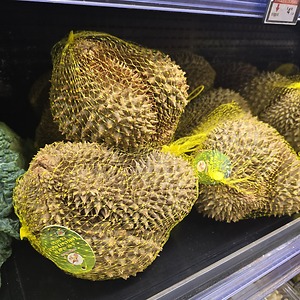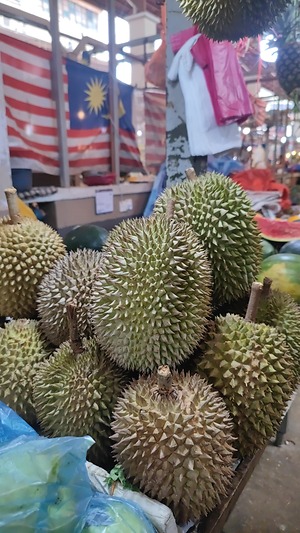


Durian
Estimated Inventory, lb : 0
This item was last sold on : 10/21/24
Description/Taste
Durian is a large spherical fruit, roughly 15-30 centimeters long and 15-20 centimeters in diameter, and it can weigh up to 18 pounds. Durian fruit is notorious for its distinguishable, malodorous aroma, which has been compared to that of Limburger cheese, rotting onions, and even gasoline. It has a hard, thick exterior that is yellow or yellow-green in color, and densely covered in sharp thorns. Inside the fruit are about five oval compartments or pods, each filled with soft, meaty pulp that varies in color from cream to yellow or even red, depending on the variety. Within the pulp are a few seeds about the size of a chestnut. The rich, smooth, custard-like pulp can be eaten at various stages of ripeness, and the reddish-brown seeds can be eaten if cooked. The pulp offers a blended sweet yet savory taste, and flavor profiles range from having notes of vanilla, banana, butterscotch or milk chocolate, to more savory notes of cream cheese, caramelized onions or even a bitter, egg-like taste. Both the texture and taste of Durian fruit is likened to a natural crème brûlée, given the fruit’s inherently high sugar and fat content.
Seasons/Availability
Durian fruit is available in the spring and summer.
Current Facts
Durian, meaning “thorny” in Malay, is a member of the mallow family, and it has earned the title “King of Fruit” in many parts of Southeast Asia where it is widely celebrated for its unique flavor as well as its health benefits. There are multiple species of Durian, but only a handful of them are commonly utilized for culinary purposes, and only one species is found on the international market; that species is botanically classified as Durio zibethinus. There are hundreds of varieties of Durian fruit, named and unnamed, with varying qualities in flavor and appearance, but again only a few are in commercial cultivation. One of the most widely exported is a variety called Monthong, which is Thai for “Golden Pillow”. It’s a sweet and creamy variety that is popular in Thailand and is grown for export to countries like the United States, where it is most commonly found frozen.
Nutritional Value
Durian fruit is rich in sugar and healthy fats, but it also has extensive vitamin and mineral content that is attributed to its many health benefits, including boosting the immune system, protecting against heart disease, aiding in the prevention of cancer, strengthening bones, lowering blood pressure, and more. Durian fruit is an excellent source of energy because it is high in carbohydrates, and also contains a good amount of dietary fiber, essential for normal function of the digestive system. It is rich in vitamin C (more so than most tropical fruits), protein, folic acid, vitamin A, B vitamins, and important minerals such as potassium, iron, calcium, magnesium, sodium, zinc, and phosphorus. Durian fruit also contains tryptophan, also known as nature’s sleeping pill, which may induce a feeling of relaxation and happiness. Hence, Durian fruit is thought to help relieve feelings of stress or depression, and has also been used to help with insomnia.
Applications
Durian fruit is most commonly eaten raw, and can be used in sweet or savory recipes. Once ripe, the tough skin can easily be cut open and the pudding-like pulp can be scooped out and eaten raw, though some recommend chilling it first. Durian fruit is used in a number of Southeast Asian recipes, particularly in desserts. It can be blended or pureed, baked into cakes or custards, or used to flavor ice cream. The flesh is often mixed with sugar and wrapped in a pancake, or wrapped in rice paper and deep-fried. Durian fruit is also canned, dried, or processed into a paste for local use as well as exporting. In Bangkok, much of the paste is mixed with pumpkin. The large, fleshy seeds may be roasted, boiled or fried and eaten as nuts, and even the young leaves and shoots are occasionally cooked as greens. Durian fruit pairs well with other tropical fruits, like mango, as well as coconut cream, sticky rice, salt, onion, and vinegar. Note that some studies have shown that Durian fruit strongly inhibits an enzyme in your body that is key to the liver’s ability to break down the toxic byproducts of alcohol, hence it is not recommended for pairing with alcoholic beverages. Durian fruit is highly perishable, as they are fully ripe just 2 to 4 days after falling off the tree. For best flavor and quality, they should be used within one week.
Ethnic/Cultural Info
Durian’s stench is so strong that the fruit has actually been banned from hotels and mass transit systems in parts of Southeast Asia, such as Singapore. The fruit’s infamous scent has even been the center of several research projects across the globe. There was a genome-mapping project headed by a team of cancer researchers in Singapore circa 2017 that not only found the source of the smell, but also discovered that the Durian plant is extremely complex, with nearly 46,000 genes—that’s about twice the number found in humans. This project and others have found that Durian fruit stinks so badly because a lot of its genes control the production of volatile sulfur compounds, which give the fruit its signature stench. A study from 2012 showed that are actually over 50 different odor-inducing compounds in the fruit, including four that were completely unknown to science at the time. Many researchers speculate that this evolution of smell happened in wild Durian fruits in order to attract animals like orangutans to eat the fruit and disperse its seeds.
Geography/History
Durian is believed to be native to Malaysia and Indonesia, specifically Borneo and Sumatra, but has since been naturalized in other areas with the necessary climate, including Thailand, Singapore and the Polynesian Islands. The durian tree prefers highly tropical climates near sea level, and needs abundant rainfall to thrive. One of the earliest known European references to the fruit dates back to the 15th century, and in the 16th century Durian was actively being traded from Lower Burma to Upper Burma where they were prized in the Royal Palace. By then, it was also being cultivated in more areas outside its native land, especially in Thailand and South Vietnam. Today, Durian is cultivated in Indonesia, the Philippines, Malaysia, and southern Thailand. It can be found in local markets in the countries where it is grown, but it is only commercially produced and exported from Thailand and Indonesia.
Recipe Ideas
Recipes that include Durian. One
| Honey Bee Sweets |
|
Durian Egg Tarts |
Podcasts

















